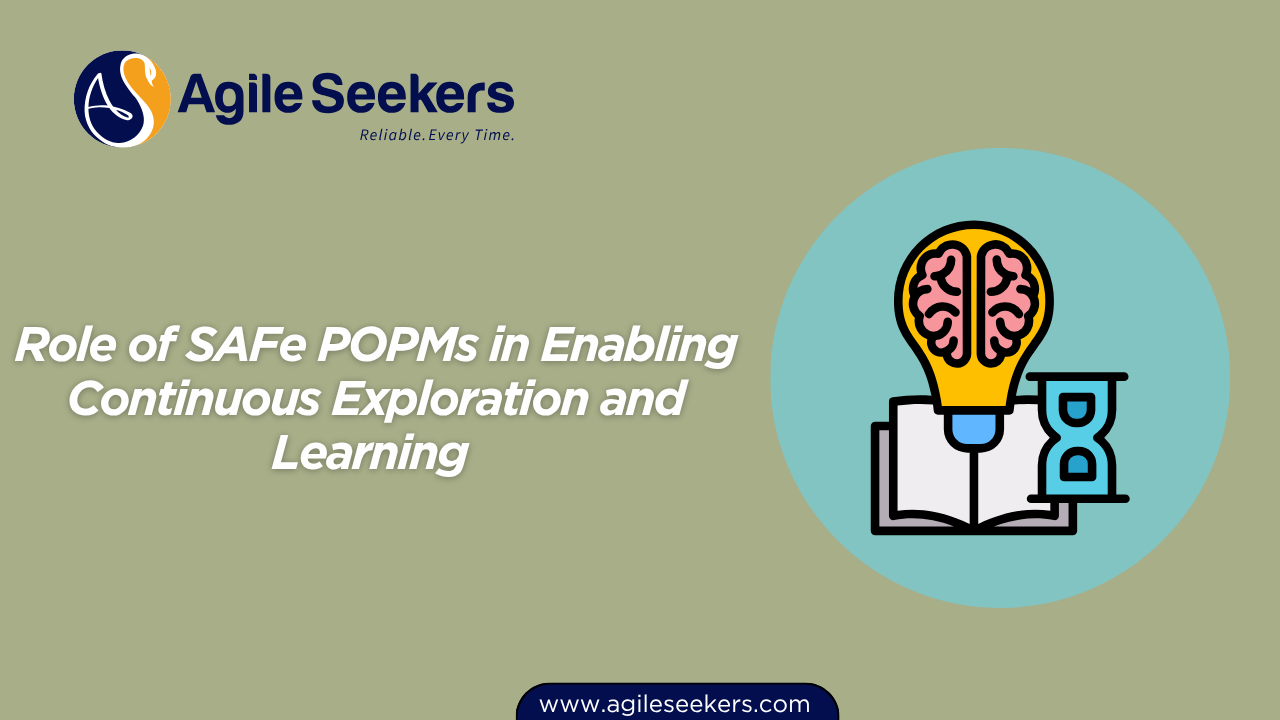Role of SAFe PO/PMs in Enabling Continuous Exploration and Learning

Continuous exploration and learning are core parts of how SAFe teams build products that genuinely solve real customer problems. The Product Owner/Product Manager (POPM) plays a central role in driving this mindset. A SAFe POPM doesn’t simply manage backlogs or prioritize items. They help teams stay curious, validate assumptions, and explore opportunities continuously, not just during planning cycles.
This article explains how SAFe POPMs enable continuous exploration and create a learning-oriented product environment.
Why Continuous Exploration Matters
Customer needs shift over time. Markets evolve. Technology influences how users expect products to behave. If a team works only on fixed plans, they risk delivering features that no longer matter.
Continuous exploration ensures that:
- Assumptions are tested early
- Teams stay close to user behavior
- Ideas evolve based on actual evidence
- Solutions stay aligned with business outcomes
The POPM is responsible for keeping this loop active and meaningful.
The POPM Mindset: Learning Before Building
A SAFe POPM encourages the team to ask questions continuously, such as:
- What problem are we solving?
- Who is facing this problem?
- What evidence shows that this problem matters?
- How do we know our solution will create value?
By keeping these questions visible in daily conversations, learning becomes an ongoing habit, not a phase that happens once.
Continuous Exploration in SAFe
Continuous exploration is part of the Continuous Delivery Pipeline and focuses on understanding customer needs and shaping what the solution should become. The POPM leads the effort to:
- Understand the customer and market context
- Define and refine the product vision
- Explore alternative approaches and ideas
- Validate feasibility and value before scaling development
For example, instead of building a large feature from a detailed document, a POPM encourages early user feedback, prototypes, and experiments to validate direction first.
How SAFe POPMs Enable Learning Across the Value Stream
1. Keeping the Product Vision Alive
A product vision shouldn’t be static. A POPM continually refines the vision based on market signals and customer feedback, ensuring that teams don’t deliver blindly against outdated assumptions.
2. Maintaining Customer-Centric Focus
The POPM brings the customer voice into everyday conversations. This includes sharing real user stories, inviting customer participation in reviews, and reminding teams of the underlying problem being solved.
3. Encouraging Experimentation
Teams learn faster when small experiments are encouraged. POPMs help teams test ideas early, even in rough form, rather than waiting to release a fully built solution.
4. Using Data for Decision-Making
Good decisions require good insights. POPMs help teams define meaningful metrics related to usage, adoption, and customer outcomes. These insights guide future backlog decisions.
5. Enabling Effective PI Planning
During PI Planning, POPMs provide clear context, priorities, and assumptions. They ensure learning activities and validation work are included intentionally, not treated as optional extras.
Learning as Part of Daily Work
Continuous learning shows up in everyday team routines:
| Activity | Learning Behavior Supported |
|---|---|
| Backlog Refinement | Re-examining priorities and questioning assumptions |
| Sprint Reviews | Gathering real user feedback and observing reactions |
| Retrospectives | Improving team processes and learning approaches |
| Daily Stand-ups | Surfacing new insights or changes early |
The POPM as a Connector
The POPM connects strategy with execution by translating business outcomes into clear backlog priorities and sharing team learning back to stakeholders. This two-way flow ensures that decision-making stays grounded and adaptive.
Building a Culture of Learning
Culture shifts through repeated, consistent behavior. POPMs encourage teams to:
- Stay curious
- Validate assumptions instead of accepting them
- Share insights openly
- Experiment early and learn fast
One simple but powerful POPM habit is asking: “What needs to be learned before we commit to this work?”
Becoming a Strong Learning-Driven POPM
If you're growing into this role or want to level up your effectiveness, structured training can help. To gain hands-on experience with real-world product value delivery, explore the POPM certification.
To strengthen alignment and leadership capability while working with Agile Release Trains, consider the SAFe Product Owner and Manager Certification.
If you prefer practical workshops that deepen day-to-day backlog and discovery techniques, you may benefit from focused POPM certification Training.
And if you're transitioning into the role for the first time, a foundational product owner certification can help you establish strong grounding in core responsibilities.
Conclusion
Continuous exploration and learning ensure that products evolve in sync with user needs and business realities. The SAFe POPM plays a pivotal role in keeping the product direction clear, enabling evidence-driven decisions, and fostering a culture where discovery never stops.
When exploration continues, value continues.
Also read - How POPMs Balance Customer Needs and Technical Constraints
Also see - How POPMs Use Metrics to Improve Release Planning




















